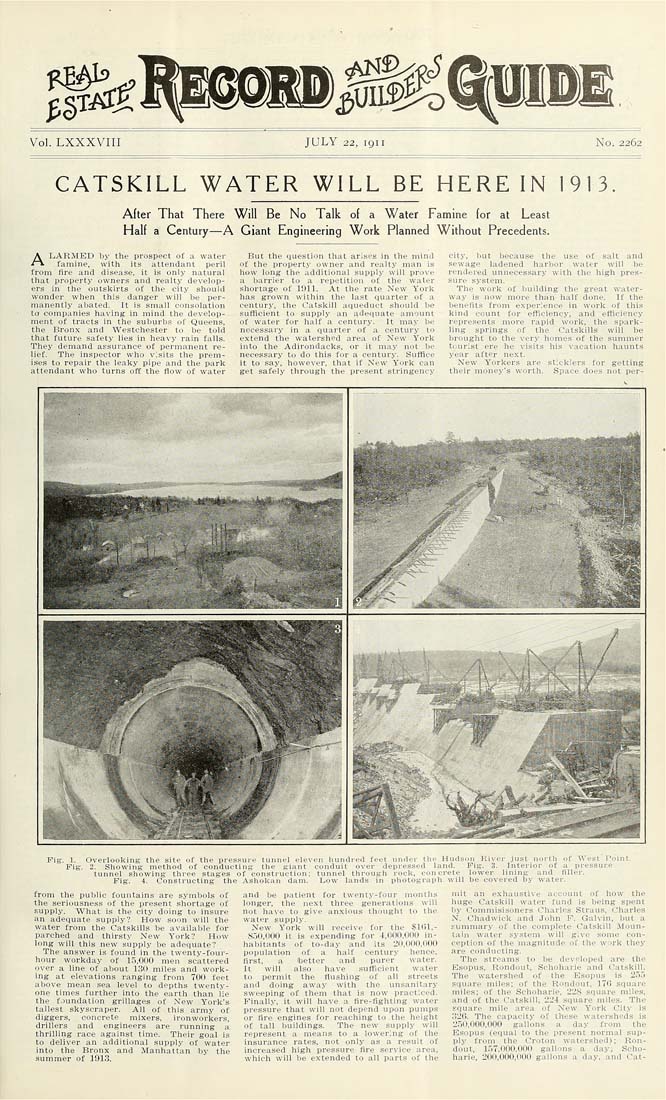Columbia University Libraries Digital Collections: The Real Estate Record
Use your browser's Print function to print these pages.
Real estate record and builders' guide: v. 88, no. 2262: July 22, 1911

Text version:
Please note: this text may be incomplete. For more information about this OCR, view About OCR text.
mm Vol. LXXXVIII JULY 22, igii No. 2262 CATSKILL WATER WILL BE HEREIN 1913. A{ter That There Will Be No Talk of a Water Famine for at Least Half a Century—A Giant Engineering Work Planned Without Precedents, ALARMED by the prospect of a water famine, with its attendant peril from tire and disease, it is only natural that property owners and realty develop¬ ers in the outskirts of the city should wonder when this danger will be per¬ manently abated. It is .'^mall consolation to companies having in mind the develop¬ ment of tracts in the suburbs of Queens, the Bronx and Westchester to be told that future safety lies in heavy rain falls. They demand assurance of permanent re¬ lief. The inspector who visits the prem¬ ises to repair the leaky pipe and the park attendant who turns off the flow of water But the cjuestion that arises in tlie mind of the property owner and realty man is how long the additional supply will prove a barrier to a repetition of the water shortage of 1911. At the rate New York ha.s grown within the last quarter of a century, the Catskill aaueduct should he suflicient to supply an adequate amount of water for half a century. It may be necessary in a quarter of a century to extend the watershed area of New York into the Adirondacks, or it may not he necessary to do this for a century. Suffice it to say, however, that if New Y'ork can get safely through the present stringency city, but because the use of salt and sewage ladeiied harbor water will be rendered unnecessary with the high pres¬ sure system. The work of building the great water¬ way is naw more than half done. If the benefits from experience in work of this kind count for efflciency, and efficiency represents more rapid work, the spark¬ ling springs of the Catskills will be brought to the very homes of the summer tourist ere he visits his vacation haunts year after next. New Y'orkers are sticklers for getting their money's worth. Space does not per- from the public fountains are symbols of the seriousness of the present shortage of supply. What is the city doing to insure an adequate supply? How soon will the water from the Catskills be available for parched and thirsty- New York? How long will this new supply be adequate? The answer is found in the twenty-four- hour workday of l;.,0(lO men scattered over a line of about 13() miles and work¬ ing at elevations ranging frum TOIl feet above mean sea level to depths twenty- one times further into the earth than lie the f.jundation grillages of New York's tallest skyscraper. All of this army of diggers, concrete mixers, ironworkers, drillers and engineers are running a thrilling race against time. Their goal is to deliver an additional supply of water into the Bronx and Manhattan hy the summer of 1913. and be patient for twenty-four months longer, the next three generations will not have to give anxious thought to the water supply. New York will receive for the $11)1,- S."jO,fX10 it is expending for 4,000,000 in¬ habitants of to-day and its 120,000,000 population of a half century hence, first, a ibetter and purer water. It will also have sufRcient water to permit the flushing of all streets and doing away with the unsanitary sweeping of them that is now practiced. Finally, it will have a fire-fighting water pressure that will not depend upon pumps or fire engines for reaching to the height of tall buildings. The new supply will represent a means to a lowering of the insurance rates, not only as a result of increased high pressure fire service area, which will be extended to all parts of the mit an exhaustive account of how the huge Catskill water fund is being spent hy Commiaisoners Charles Straus, Charles N. Chadwick and John F. Galvin, hut a eummary of the complete Catskill Moun¬ tain water system will give some con¬ ception of the magnitude of the work they are conducting. The streams to be dev|iloped are the Esopus, Rondout, Schoharie and Catskijl. The watershed of the Esopus is 255 square iniles; of the Rondout, 170 square miles; of the Schoharie, 22S square miles, and of the Catskill, 224 square miles. The f^quare mile area of New York City is '.i'lG. The capacity of these watersheda is L'.^0,000,000 gallons a day from the Esopus (equal to the present normal sup¬ ply from the Croton watershed); Ron¬ dout, 157,000.000 gallons a day; Scho¬ harie, 200,000,1100 gallons a day, and Cat-